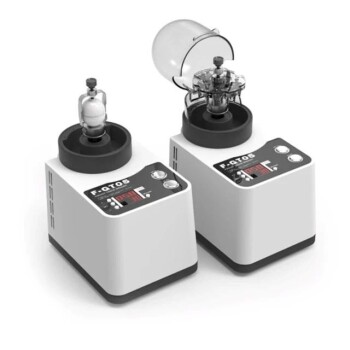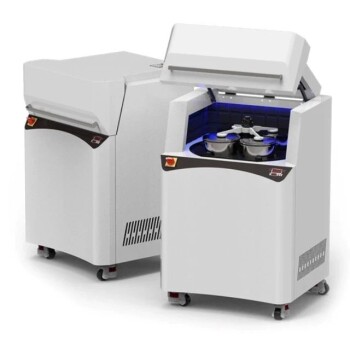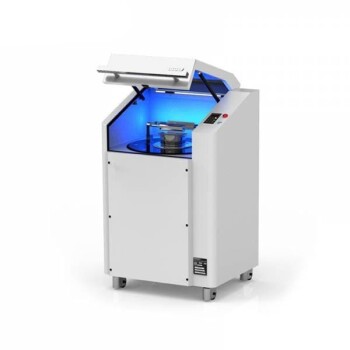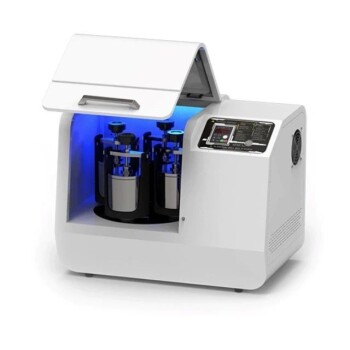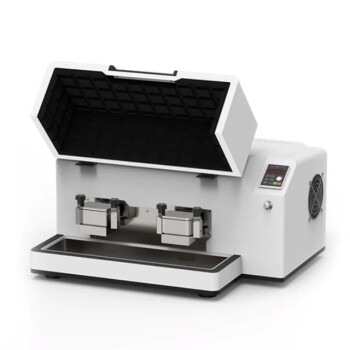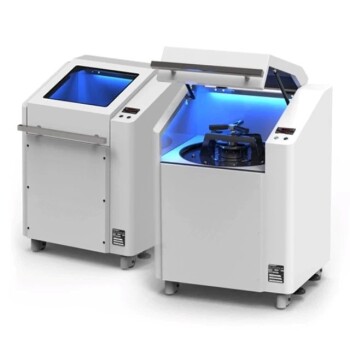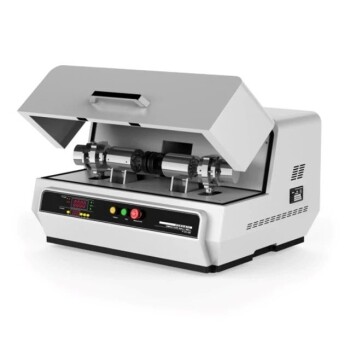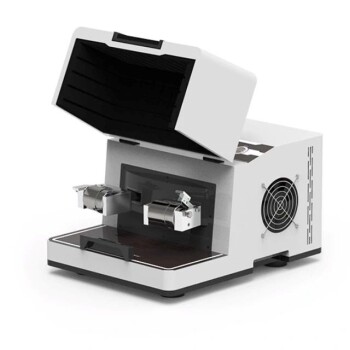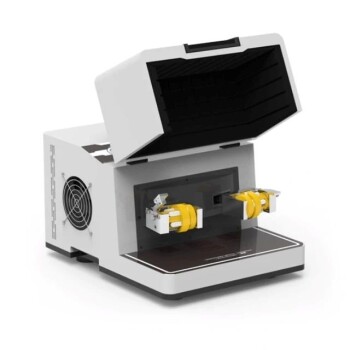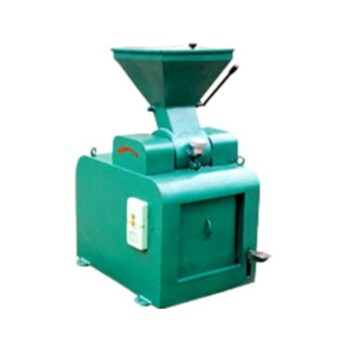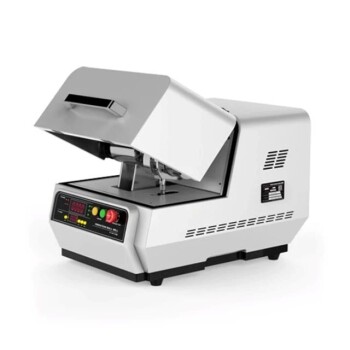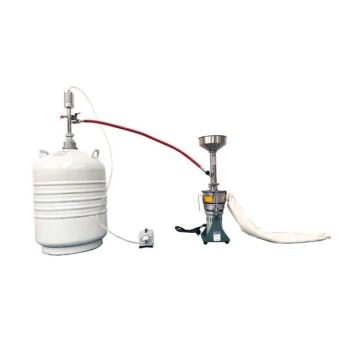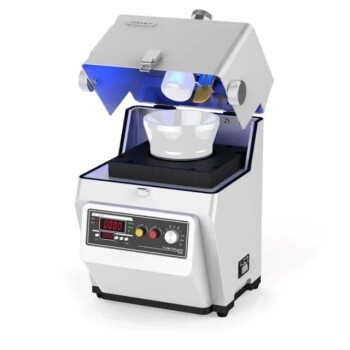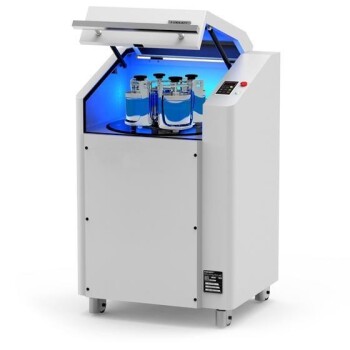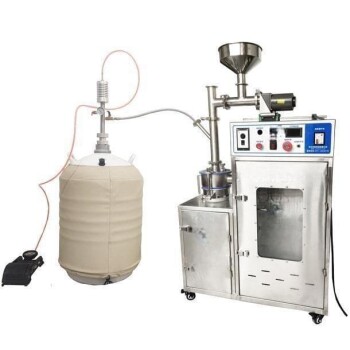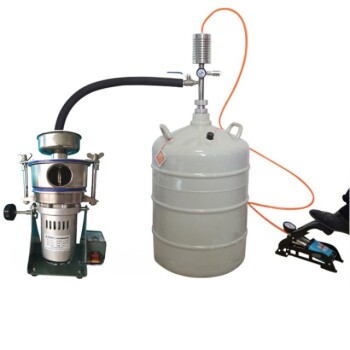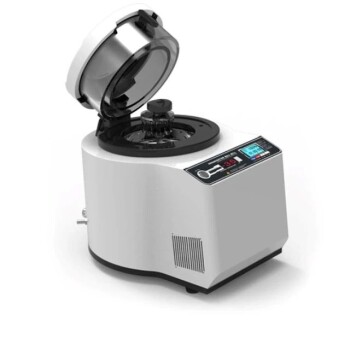냉동 조직 분쇄기 소개
정의 및 중요성
냉동 조직 분쇄기는 실험실 환경에서 없어서는 안 될 도구로, 교차 오염을 방지하기 위해 검체를 분쇄하는 데 중추적인 역할을 합니다. 기존 방식과 달리 이 분쇄기는 대규모 처리를 효율적으로 처리하도록 설계되어 분쇄 과정 내내 시료의 무결성을 유지합니다. 이 기능은 시료 순도가 가장 중요한 생명공학 및 제약과 같은 분야에서 특히 중요합니다.
냉동 조직 분쇄기의 중요성은 단순한 효율성 그 이상입니다. 기존 분쇄 방법의 일반적인 문제인 오염 위험을 최소화하도록 설계되었습니다. 이 분쇄기는 첨단 기술과 재료를 사용하여 번거롭고 오류가 발생하기 쉬운 검체 전처리 과정에 대한 신뢰할 수 있는 솔루션을 제공합니다. 이를 통해 실험실 결과의 정확성을 향상시킬 뿐만 아니라 워크플로우를 간소화하여 관리가 용이하고 시간이 덜 소요됩니다.
또한 동결 조직 분쇄기의 다용도성 또한 주목할 만합니다. 연조직부터 딱딱한 뼈까지 다양한 유형의 시료에 맞게 조정할 수 있어 각 특정 재료에 최적화된 분쇄 공정을 보장합니다. 이러한 적응성은 다양한 과학 분야에서 널리 채택되는 핵심 요소입니다.
요약하면, 냉동 조직 분쇄기는 단순한 도구가 아니라 현대 실험실에서 필수적인 구성 요소로서 기존 방법과 오염 없는 정밀한 시료 처리의 필요성 사이의 간극을 메워주는 역할을 합니다. 과학 연구의 증가하는 수요와 실험실 절차에서 더 높은 표준을 추구하는 추세를 반영하여 개발과 적용이 계속 발전하고 있습니다.
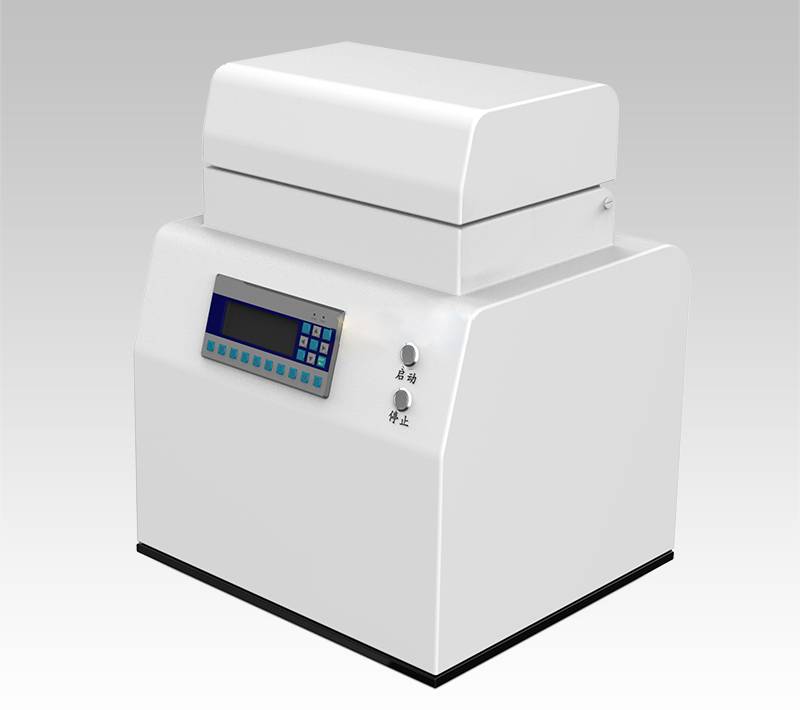
올바른 분쇄기 선택
적절한 냉동 조직 분쇄기를 선택하려면 다양한 작동 매개변수와 재료별 요구 사항을 고려한 다각적인 접근 방식이 필요합니다. 분쇄 모드 진동 모드 는 분쇄기의 효율성과 효과를 결정하는 데 중추적인 역할을 합니다. 분쇄기는 수직, 수평 또는 3차원 등 여러 차원으로 진동할 수 있으며, 각각 특정 용도에 맞는 뚜렷한 이점을 제공합니다. 예를 들어, 수직 진동은 섬세한 시료에 이상적이며, 3차원 진동은 견고한 재료에 적합한 보다 철저한 분쇄 공정을 제공합니다.
연삭 방법 연삭 방법 은 또 다른 중요한 요소입니다. 다음과 같은 다양한 유형의 분쇄기가 있습니다. 유성 볼 밀 , 모르타르 밀, 나이프 밀, 디스크 밀, 조 크러셔 등 다양한 종류의 분쇄기가 다양한 분쇄 요구 사항을 충족합니다. 유성 볼 밀 은 높은 에너지 효율과 미세 연삭 기능으로 잘 알려져 있어 연구용 애플리케이션에 적합합니다. 반대로 나이프 밀은 속도와 단순성으로 인해 대량 시료 처리에 더 실용적입니다.
또한 처리되는 재료의 특정 요구 사항 간과할 수 없습니다. 경도, 밀도, 화학적 특성이 다양한 재료는 각기 다른 분쇄 방식이 필요합니다. 예를 들어, 연조직은 과도한 열화를 방지하기 위해 부드러운 연삭 방법이 필요한 반면, 단단한 조직은 보다 공격적인 연삭 기술이 필요합니다. 따라서 최적의 시료 무결성과 처리 효율을 보장하는 분쇄기를 선택하려면 재료의 특성을 이해하는 것이 필수적입니다.
요약하면, 냉동 조직 분쇄기의 선택은 실험실 시료 준비에서 최상의 결과를 얻기 위해 진동 모드, 분쇄 방법 및 재료별 요구 사항의 균형을 맞추는 미묘한 과정입니다.
역사적 발전
초기 혁신
실험실용 밀링 기기의 진화는 1923년 Retsch가 최초의 모르타르형 밀링 기기를 개발하면서 시작되었습니다. 이 선구적인 혁신은 더욱 정교한 연삭 기술의 토대를 마련했습니다. 1962년에 FRITSCH는 유성 볼 밀 을 출시하여 밀링 공정의 정밀도와 효율성을 획기적으로 개선했습니다. 이 혁신은 이후 몇 년 동안 Tomy 및 MP와 같은 회사에서 유사한 기술을 도입하는 데 빠르게 이어졌습니다.
이러한 초기 개발은 실험실 밀링 기기의 환경을 형성하는 데 중추적인 역할을 했습니다. 유성 볼 밀의 도입 유성 볼 밀 의 도입으로 더욱 제어되고 효율적인 연삭이 가능해져 섬세한 시료를 다루고 오염을 최소화하는 데 특히 유용했습니다. 이러한 혁신의 시대는 과학 연구 및 산업 응용 분야의 진화하는 요구를 충족하기 위해 밀링 기술의 지속적인 개선을 주도하면서 이 분야의 발전을 위한 발판을 마련했습니다.
국내 및 국제 동향
수입 냉동 티슈 분쇄기는 종종 고가의 가격표를 달고 있지만, 최근 몇 년 동안 국내 제조업체는 상당한 발전을 이루었습니다. 국산 분쇄기의 품질과 기술 발전이 빠르게 개선되어 작동 세부 사항의 격차를 효과적으로 좁히고 사용자 경험을 향상시켰습니다. 이러한 변화는 특히 다음 영역에서 두드러집니다:
-
운영 효율성: 국내 크러셔는 이제 해외 크러셔와 비슷한 수준의 운영 효율성을 제공합니다. 정밀 제어, 자동화된 프로세스, 사용자 친화적인 인터페이스와 같은 기능이 표준이 되어 사용자가 광범위한 교육이나 전문 지식 없이도 동일한 수준의 성능을 달성할 수 있게 되었습니다.
-
커스터마이징 및 지원: 국내 옵션의 주요 장점 중 하나는 특정 요구에 맞게 분쇄기를 맞춤화할 수 있다는 점입니다. 제조업체는 특수 진동 모드 또는 연삭 방법과 같은 고유한 요구 사항을 해결하는 맞춤형 솔루션을 제공할 수 있습니다. 또한 현지 지원 및 유지보수 서비스를 보다 쉽게 이용할 수 있어 가동 중단 시간을 줄이고 지속적인 작동을 보장합니다.
-
비용 효율성: 국산 분쇄기의 초기 투자 및 지속적인 유지보수 비용은 일반적으로 수입 모델보다 저렴합니다. 이러한 비용 효율성 덕분에 실험실과 연구 기관은 장비의 품질이나 성능에 영향을 주지 않으면서 예산을 보다 효율적으로 배분할 수 있습니다.
-
기술 통합: 이제 국산 분쇄기에는 IoT 연결, 실시간 모니터링, 데이터 분석과 같은 첨단 기술이 통합되어 있습니다. 이러한 기능은 운영 효율성을 향상시킬 뿐만 아니라 분쇄 공정에 대한 귀중한 통찰력을 제공하여 사용자가 워크플로우를 최적화하고 더 나은 결과를 얻을 수 있도록 지원합니다.
요약하면, 국내 냉동 조직 분쇄기의 급속한 발전으로 많은 실험실과 연구 기관에서 냉동 조직 분쇄기가 실용적이고 매력적인 옵션이 되었습니다. 비슷한 성능, 더 나은 맞춤화, 비용 효율성을 제공함으로써 이러한 분쇄기는 조직 분쇄 공정을 개선하려는 사람들에게 점점 더 선호되는 선택이 되고 있습니다.
분류 및 원리
진동 모드
분쇄기는 특정 응용 분야와 재료 특성에 맞게 다양한 진동 모드를 제공합니다. 이러한 모드는 크게 수직, 수평 및 3차원 진동 유형으로 분류할 수 있으며, 각각 고유한 장점을 제공합니다.
- 수직 진동: 이 모드는 정밀하고 제어된 연삭이 필요한 재료에 특히 효과적입니다. 재료 손실을 최소화하고 균일성이 중요한 섬세한 시료에 이상적입니다.
- 수평 진동: 대량 처리에 가장 적합한 이 모드는 높은 처리량을 제공하며 대량의 재료에 효율적입니다. 미세한 정밀도보다 속도와 양이 더 중요한 산업에서 자주 사용됩니다.
- 3차원 진동: 이 고급 모드는 수직 진동과 수평 진동의 장점을 결합하여 보다 포괄적인 연삭 작업을 제공합니다. 부드러운 재료부터 단단한 재료까지 다양한 재료에 적합하며 특히 균일한 연삭을 달성하는 데 효과적입니다.
각 진동 모드에는 고유한 응용 분야가 있으므로 처리할 재료의 특정 요구 사항에 따라 적합한 분쇄기를 선택하는 것이 중요합니다.
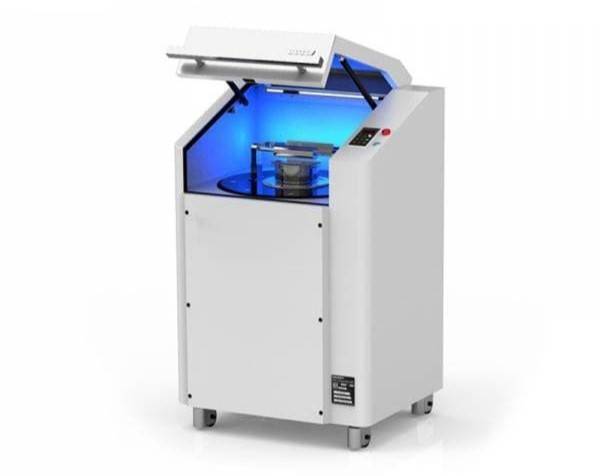
분쇄 방법
분쇄 방법은 냉동 조직 샘플을 효과적으로 처리하는 데 매우 중요하며, 교차 오염을 일으키지 않고 미세하게 분쇄할 수 있도록 합니다. 분쇄 방법의 선택은 처리할 재료의 특정 요구 사항, 원하는 입자 크기, 작업에 필요한 효율성에 따라 달라집니다.
현장에서는 몇 가지 일반적인 연삭 방법이 사용되며, 각 방법마다 고유한 장점과 용도가 있습니다. 유성 볼 밀 은 높은 에너지 효율로 잘 알려져 있으며 특히 고도의 미세도가 필요한 재료에 유용합니다. 원심력을 사용하여 그라인딩 볼을 가속시켜 시료에 충격을 가하여 미세하고 균일한 입자 크기를 만드는 방식으로 작동합니다.
모르타르 밀 은 특히 부드러운 분쇄 과정이 필요한 재료에 널리 사용되는 또 다른 선택입니다. 이 분쇄기는 절구와 유봉 메커니즘을 사용하여 샘플을 분쇄하므로 보다 공격적인 방법으로 손상될 수 있는 섬세한 재료에 이상적입니다.
보다 공격적인 접근이 필요한 재료에 적합합니다, 나이프 밀 과 디스크 밀 을 사용하는 경우가 많습니다. 나이프 밀은 날카로운 칼날을 사용하여 재료를 작은 조각으로 자르고, 디스크 밀은 회전 디스크를 사용하여 샘플을 연마합니다. 두 방법 모두 단단하고 섬유질이 많은 재료에 효과적입니다.
마지막으로 조 크러셔 는 큰 샘플의 초기 분쇄에 사용됩니다. 볼 밀이나 모르타르 밀과 같이 추가 가공 전에 재료의 크기를 줄이는 데 특히 유용합니다.
요약하면, 조직 가공에서 원하는 결과를 얻으려면 적절한 연삭 방법을 선택하는 것이 필수적입니다. 각 방법에는 강점이 있으며 다양한 유형의 재료와 가공 요구 사항에 적합합니다.
그라인딩 볼 선택
재료 고려 사항
그라인딩 볼 재료의 선택은 분쇄 공정의 효율성과 장비의 수명에 큰 영향을 미치는 중요한 요소입니다. 각 재료는 처리되는 조직 시료의 특정 요구 사항에 따라 분쇄 성능을 향상시키거나 방해할 수 있는 고유한 특성을 제공합니다.
그라인딩 볼의 일반적인 재료는 다음과 같습니다:
-
스테인리스 스틸: 내구성과 내식성으로 잘 알려진 스테인리스 스틸 볼은 다용도로 사용할 수 있으며 다양한 조직 유형을 처리할 수 있습니다. 그러나 금속 오염이 발생할 수 있으며, 이는 일부 민감한 애플리케이션에서 우려되는 문제입니다.
-
알루미늄 산화물: 이 볼은 매우 단단하고 마모에 강해 충격이 심한 연삭에 이상적입니다. 또한 반응성이 없어 오염의 위험이 적습니다. 그러나 높은 비용이 제한 요인이 될 수 있습니다.
-
마노: 마노 볼은 경도가 우수하고 마찰 계수가 낮아 시료 손실을 최소화하면서 효율적으로 분쇄할 수 있습니다. 특히 오염을 최소화해야 하는 섬세한 시료에 적합합니다.
-
카바이드: 카바이드 볼은 내구성이 매우 뛰어나며 고압 연삭 환경을 견딜 수 있습니다. 높은 정밀도가 필요하고 조직 샘플의 경도가 중요한 응용 분야에 자주 사용됩니다.

| 재질 | 장점 | 단점 |
|---|---|---|
| 스테인리스 스틸 | 내구성, 부식 방지, 다용도성 | 금속 오염 가능성 |
| 알루미늄 산화물 | 단단하고 내마모성, 비반응성 | 높은 비용 |
| 마노 | 단단하고 마찰이 적으며 시료 손실 최소화 | 깨지기 쉬움, 극한 조건에서 부서질 수 있음 |
| 카바이드 | 내구성이 매우 뛰어난 고압 환경 | 비싸고 일부 응용 분야에서는 너무 단단할 수 있음 |
재료 선택은 조직 샘플의 특정 요구 사항, 원하는 분쇄 효율, 잠재적 오염에 대한 허용 오차에 따라 결정해야 합니다. 각 재료에는 고유한 장단점이 있으므로 분쇄 효과와 장비의 수명을 최적화하는 데 있어 선택 과정이 매우 중요합니다.
직경 및 볼 수
연삭 볼의 직경과 개수는 분쇄 효과와 전반적인 생산 효율에 큰 영향을 미치는 중요한 매개변수입니다. 이러한 매개변수는 처리되는 재료의 특정 특성과 원하는 결과에 따라 세심하게 선택해야 합니다.
예를 들어, 다양한 볼 직경과 수량이 미치는 일반적인 영향을 요약한 다음 표를 살펴보십시오:
| 볼 직경(mm) | 볼 개수 | 분쇄 효과 | 생산 효율성 |
|---|---|---|---|
| 10 | 100 | 보통 | 높음 |
| 20 | 50 | 높음 | 보통 |
| 30 | 25 | 매우 높음 | 낮음 |
큰 볼은 일반적으로 더 큰 질량과 운동 에너지로 인해 더 강력한 분쇄 효과를 제공하지만 분쇄기 내에서 더 많은 부피를 차지하여 전체 분쇄 효율을 떨어뜨릴 수 있습니다. 반대로 작은 볼은 단위 시간당 충격 횟수를 늘려 더 높은 효율을 제공하지만, 큰 볼과 같은 수준의 분쇄력을 제공하지 못할 수 있습니다.
따라서 볼 직경과 수의 최적 조합은 재료의 경도, 취약성 및 최종 제품의 요구되는 미세도를 고려하고 신중한 실험을 통해 결정해야 합니다. 이러한 균형을 통해 연삭 공정이 효과적이고 효율적이며 실험실 또는 산업 응용 분야의 특정 요구 사항을 충족할 수 있습니다.
올바른 분쇄기 선택
진동식 및 유성 볼 분쇄기 비교
냉동 조직 샘플을 분쇄할 때 흔히 고려되는 분쇄기 유형은 진동식 볼 밀과 유성 볼 밀 . 두 가지 모두 고유한 특성과 운영 효율성을 가지고 있지만 에너지 활용과 분쇄 결과 측면에서 큰 차이가 있습니다.
진동 볼 밀은 단시간에 많은 양의 연삭 에너지를 생성할 수 있는 것으로 알려져 있습니다. 밀 챔버 내에서 연삭 볼이 빠르게 진동하기 때문에 재료를 빠르고 효율적으로 처리할 수 있습니다. 이러한 효율성은 많은 양의 시료를 처리하거나 시간이 중요한 요소일 때 특히 유리합니다. 진동식 볼 밀의 연삭 효과는 속도에도 불구하고 종종 다음과 비슷한 수준입니다. 유성 볼 밀 에 필적하는 분쇄 효과를 얻을 수 있어 많은 실험실 응용 분야에 적합한 옵션입니다.
반면에 유성 볼 밀 은 보다 제어되고 미묘한 연삭 공정을 제공합니다. 이 밀은 연삭 볼이 복잡하고 높은 에너지 궤적을 따라 움직이는 행성 운동 원리로 작동합니다. 그 결과 보다 균일하고 철저한 연삭 효과를 얻을 수 있어 섬세하거나 민감한 재료에 특히 유용합니다. 반면 유성 볼 밀 은 원하는 연삭 결과를 얻기 위해 더 많은 시간이 필요할 수 있지만, 연삭 공정을 정밀하게 제어할 수 있기 때문에 최종 제품의 품질이 더 우수한 경우가 많습니다.
| 특징 | 진동 볼 밀 | 유성 볼 밀 |
|---|---|---|
| 연삭 에너지 | High | 제어 |
| 시간 효율성 | 높음 | 보통 |
| 연삭 효과 | 비슷함 | 우수 |
| 응용 분야 적합성 | 대량 처리 | 섬세한 재료 |
요약하면, 진동식 볼 밀은 속도와 에너지 효율이 뛰어나지만, 유성 볼 밀 은 보다 정교하고 제어된 연삭 공정을 제공하므로 더 높은 수준의 정밀도가 필요한 재료에 이상적입니다. 이 두 가지 유형의 분쇄기 중 선택은 궁극적으로 실험실의 특정 요구 사항과 처리되는 재료의 특성에 따라 달라집니다.
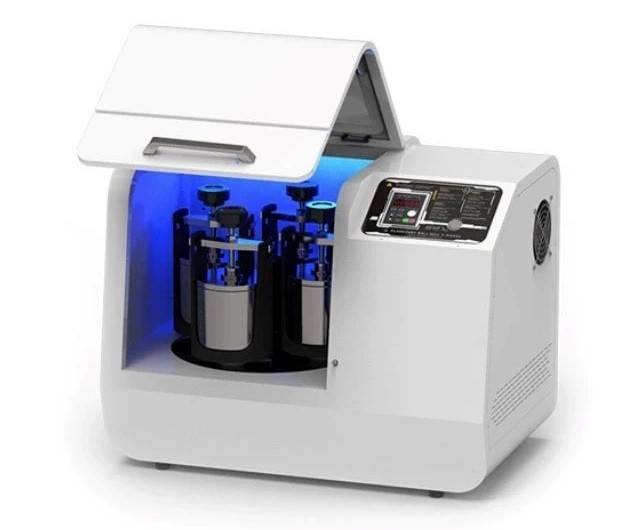
운영 고려 사항
냉동 조직 분쇄기를 선택할 때는 각 브랜드별 운영상의 뉘앙스를 이해하는 것이 필수적입니다. 이러한 차이는 분쇄 공정의 효율성과 효과에 큰 영향을 미칠 수 있습니다. 예를 들어, 수직, 수평, 3차원 등 진동 모드에 따라 필요에 가장 적합한 시료 준비 유형이 결정될 수 있습니다. 마찬가지로 분쇄 방법도 다음과 같이 다양할 수 있습니다. 유성 볼 밀 에서 모르타르 밀에 이르기까지 다양한 분쇄 방법은 시료의 최종 입자 크기와 균질성에 영향을 미칩니다.
특정 요구사항에 가장 적합한 제품을 선택하려면 고객 리뷰를 읽는 것뿐만 아니라 직접 시험해 보는 것이 좋습니다. 리뷰는 분쇄기의 사용자 경험, 내구성 및 전반적인 성능에 대한 인사이트를 제공할 수 있습니다. 그러나 개인 시험을 통해 장비의 적합성을 직접 평가하여 실험실이나 연구 환경의 고유한 요구 사항을 충족하는지 확인할 수 있습니다. 이러한 실습 방식은 제조업체의 주장을 검증하는 데 도움이 되며, 선택한 분쇄기가 운영 목표와 시료 처리 요구 사항에 부합하는지 확인할 수 있습니다.

